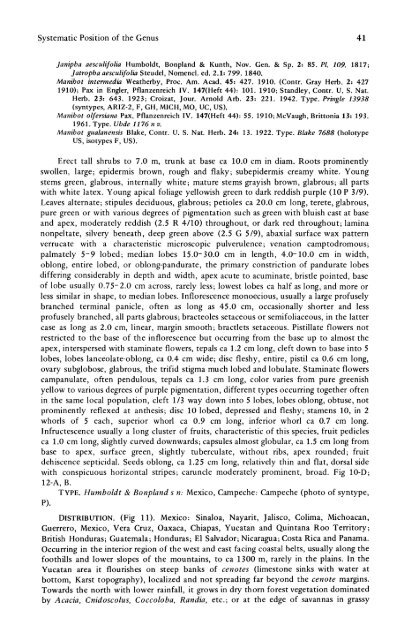Manihot Manihotoides (Euphorbiaceae) - CNCFlora
Manihot Manihotoides (Euphorbiaceae) - CNCFlora
Manihot Manihotoides (Euphorbiaceae) - CNCFlora
Create successful ePaper yourself
Turn your PDF publications into a flip-book with our unique Google optimized e-Paper software.
Systematic<br />
Position of the Genus 41<br />
Janipha aesculifolia Humboldt, Bonpland & Kunth, Nov. Gen. & Sp. 2: 85. PI. 109. 1817;<br />
Jatropha aesculifolia Steudel, Nomencl. ed. 2.1: 799. 1840.<br />
<strong>Manihot</strong> intermedia Weatherby, Proc. Am. Acad. 45: 427. 1910. (Contr. Gray Herb. 2: 427<br />
1910); Pax in Engler, Pflanzenreich IV. 147(Heft 44): 101. 1910; Standley, Contr. U. S. Nat.<br />
Herb. 23: 643. 1923; Croizat, Jour. Arnold Arb. 23: 221. 1942. Type. Pringle 13938<br />
(syntypes, ARIZ-2, F, GH, MICH, MO, UC, US).<br />
<strong>Manihot</strong> olfersiana Pax, Pflanzenreich IV. 147(Heft 44): 55. 1910; McVaugh, Brittonia 13: 193.<br />
1961. Type. Ubde 1176 nv.<br />
<strong>Manihot</strong> gualanensis Blake, Contr. U. S. Nat. Herb. 24: 13. 1922. Type. Blake 7688 (holotype<br />
US, isotypes F, US).<br />
Erect tall shrubs to 7.0 m, trunk at base ca 10.0 cm in diam. Roots prominently<br />
swollen, large; epidermis brown, rough and flaky; subepidermis creamy white. Young<br />
stems green, glabrous, internally white; mature stems grayish brown, glabrous; all parts<br />
with white latex. Young apical foliage yellowish green to dark reddish purple (10 P 3/9).<br />
Leaves alternate; stipules deciduous, glabrous; petioles ca 20.0 cm long, terete, glabrous,<br />
pure green or with various degrees of pigmentation such as green with bluish cast at base<br />
and apex, moderately reddish (2.5 R 4/10) throughout, or dark red throughout; lamina<br />
nonpeltate, silvery beneath, deep green above (2.5 G 5/9), abaxial surface wax pattern<br />
verrucate with a characteristic microscopic pulverulence; venation camptodromous;<br />
palmately 5-9 lobed; median lobes 15.0-30.0 cm in length, 4.0-10.0 cm in width,<br />
oblong, entire lobed, or oblong-pandurate, the primary constriction of pandurate lobes<br />
differing considerably in depth and width, apex acute to acuminate, bristle pointed, base<br />
of lobe usually 0.75-2.0 cm across, rarely less; lowest lobes ca half as long, and more or<br />
less similar in shape, to median lobes. Inflorescence monoecious, usually a large profusely<br />
branched terminal panicle, often as long as 45.0 cm, occasionally shorter and less<br />
profusely branched, all parts glabrous; bracteoles setaceous or semifoliaceous, in the latter<br />
case as long as 2.0 cm, linear, margin smooth; bractlets setaceous. Pistillate flowers not<br />
restricted to the base of the inflorescence but occurring from the base up to almost the<br />
apex, interspersed with staminate flowers, tepals ca 1.2 cm long, cleft down to base into 5<br />
lobes, lobes lanceolate-oblong, ca 0.4 cm wide; disc fleshy, entire, pistil ca 0.6 cm long,<br />
ovary subglobose, glabrous, the trifid stigma much lobed and lobulate. Staminate flowers<br />
campanulate, often pendulous, tepals ca 1.3 cm long, color varies from pure greenish<br />
yellow to various degrees of purple pigmentation, different types occurring together often<br />
in the same local population, cleft 1/3 way down into 5 lobes, lobes oblong, obtuse, not<br />
prominently reflexed at anthesis; disc 10 lobed, depressed and fleshy; stamens 10, in 2<br />
whorls of 5 each, superior whorl ca 0.9 cm long, inferior whorl ca 0.7 cm long.<br />
Infructescence usually a long cluster of fruits, characteristic of this species, fruit pedicles<br />
ca 1.0 cm long, slightly curved downwards; capsules almost globular, ca 1.5 cm long from<br />
base to apex, surface green, slightly tuberculate, without ribs, apex rounded; fruit<br />
dehiscence septicidal. Seeds oblong, ca 1.25 cm long, relatively thin and flat, dorsal side<br />
with conspicuous horizontal stripes; caruncle moderately prominent, broad. Fig 10-D;<br />
12-A, B.<br />
TYPE. Humboldt & Bonpland s n: Mexico, Campeche: Campeche (photo of syntype,<br />
P).<br />
DISTRIBUTION. (Fig 11). Mexico: Sinaloa, Nayarit, Jalisco, Colima, Michoacan,<br />
Guerrero, Mexico, Vera Cruz, Oaxaca, Chiapas, Yucatan and Quintana Roo Territory;<br />
British Honduras; Guatemala; Honduras; El Salvador; Nicaragua; Costa Rica and Panama.<br />
Occurring in the interior region of the west and east facing coastal belts, usually along the<br />
foothills and lower slopes of the mountains, to ca 1300 m, rarely in the plains. In the<br />
Yucatan area it flourishes on steep banks of cenotes (limestone sinks with water at<br />
bottom, Karst topography), localized and not spreading far beyond the cenote margins.<br />
Towards the north with lower rainfall, it grows in dry thorn forest vegetation dominated<br />
by Acacia, Cnidoscolus, Coccoloba, Randia, etc.; or at the edge of savannas in grassy

















